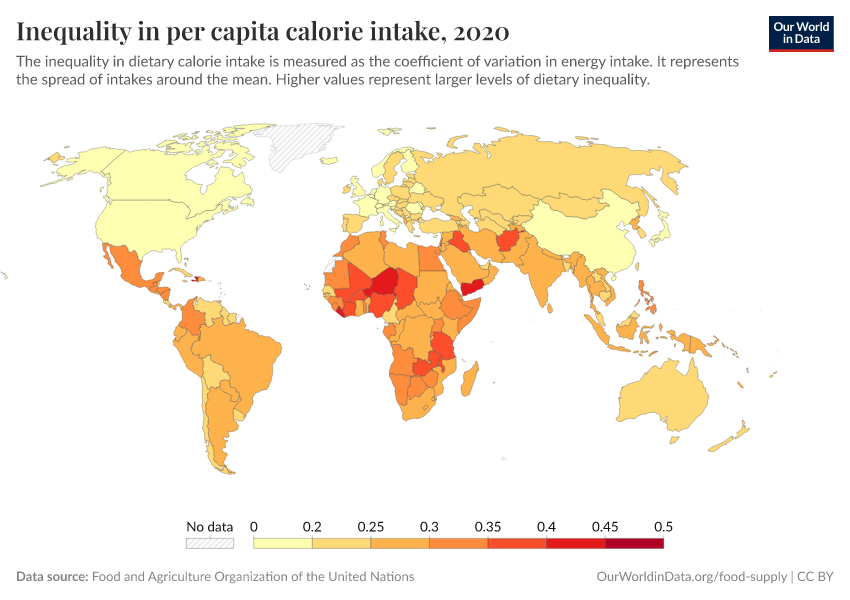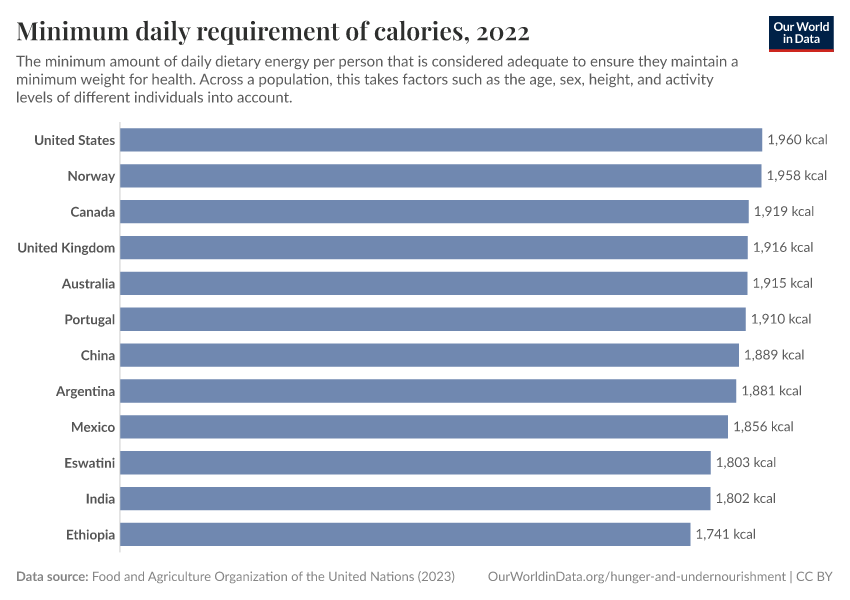What is undernourishment and how is it measured?
How do we measure the prevalence of hunger across the world?
‘Undernourishment’ is the main indicator used by the Food and Agriculture Organization of the United Nations to measure the extent of food supplies and nutrition. It is often used interchangeably with the term ‘hunger’.
Undernourishment is solely determined by the sufficiency of energy (calorie) intake. It does not consider the quality or diversity of someone’s diet. That means it is only one component of malnutrition: a broader term that also captures other types of nutrient deficiencies, such as micronutrients.
The prevalence of undernourishment in any given country or region measures the share of the population that has a daily food intake that is insufficient to provide, on average, the amount of dietary energy required to maintain a normal, active and healthy life. That is, the share of people who do not get enough calories to live a healthy life.

How is undernourishment measured?
To judge whether someone was undernourished we would need to know two things:
- How many calories they consume;
- How many calories they need to maintain a healthy life.
This might be easy for a known individual, but measuring this across a whole population is more difficult.
The amount of calories that people need can be very different: factors such as someone’s height, weight, sex, age, and activity levels will mean that some people need more calories than others.
The amount of calories that people consume also varies widely – some people eat more than their requirements – which can lead to obesity – while others eat well below their requirements.
This means we cannot simply calculate undernourishment from an average of calorie consumption and requirements.
To take account of this, the UN FAO address inequalities using three factors: 1:
- They estimate the average availability of calories (energy) across the population.
- They measure the levels of inequalities in food consumption within a population. This is called the Coefficient of Variation (CV) of energy intake. This metric is shown in the map. As we see, this value varies from country to country depending on the inequalities in food supply.
- They use demographic information – such as age structure, sex, height, and activity levels – for each country to assess the distribution of energy requirements. This means the ‘minimum energy requirement’ for each country is slightly different, as shown on the map.
Using these three factors, they then calculate undernourishment using a ‘parametric probability density function’. This indicates the cumulative probability across a population that someone has a daily energy intake that is lower than the minimum requirements.
This undernourishment measure, therefore, does not tell us anything about what specific individuals are undernourished. But it gives us an estimate of what share of a population does not get enough calories to eat.


Keep reading at Our World in Data
Endnotes
FAO, IFAD, UNICEF, WFP and WHO. 2021. The State of Food Security and Nutrition in the World 2021. Transforming food systems for food security, improved nutrition and affordable healthy diets for all. Rome, FAO.
Cite this work
Our articles and data visualizations rely on work from many different people and organizations. When citing this article, please also cite the underlying data sources. This article can be cited as:
Hannah Ritchie (2022) - “What is undernourishment and how is it measured?” Published online at OurWorldinData.org. Retrieved from: 'https://archive.ourworldindata.org/20251204-144539/undernourishment-definition.html' [Online Resource] (archived on December 4, 2025).BibTeX citation
@article{owid-undernourishment-definition,
author = {Hannah Ritchie},
title = {What is undernourishment and how is it measured?},
journal = {Our World in Data},
year = {2022},
note = {https://archive.ourworldindata.org/20251204-144539/undernourishment-definition.html}
}Reuse this work freely
All visualizations, data, and code produced by Our World in Data are completely open access under the Creative Commons BY license. You have the permission to use, distribute, and reproduce these in any medium, provided the source and authors are credited.
The data produced by third parties and made available by Our World in Data is subject to the license terms from the original third-party authors. We will always indicate the original source of the data in our documentation, so you should always check the license of any such third-party data before use and redistribution.
All of our charts can be embedded in any site.